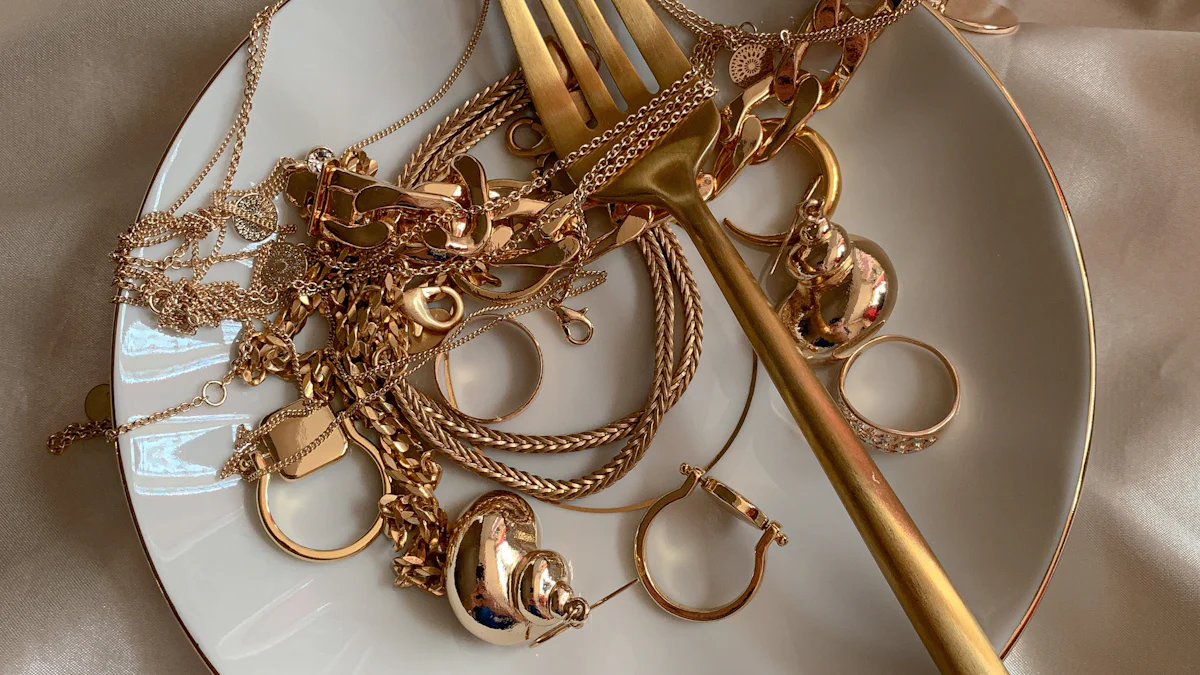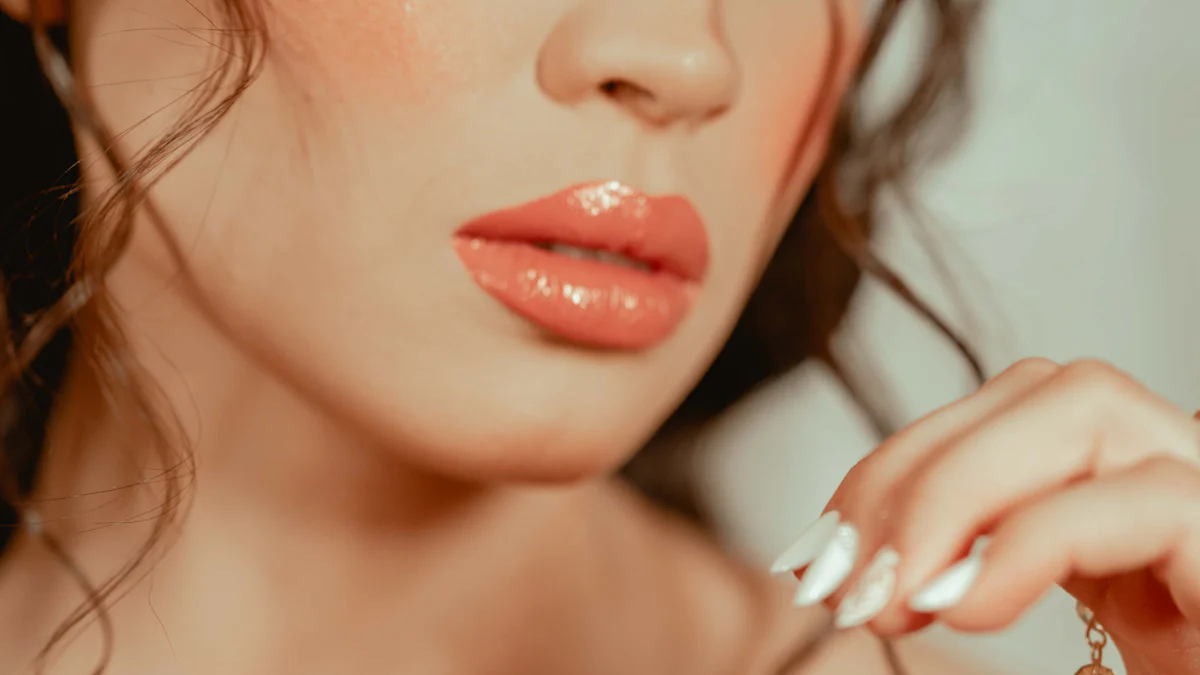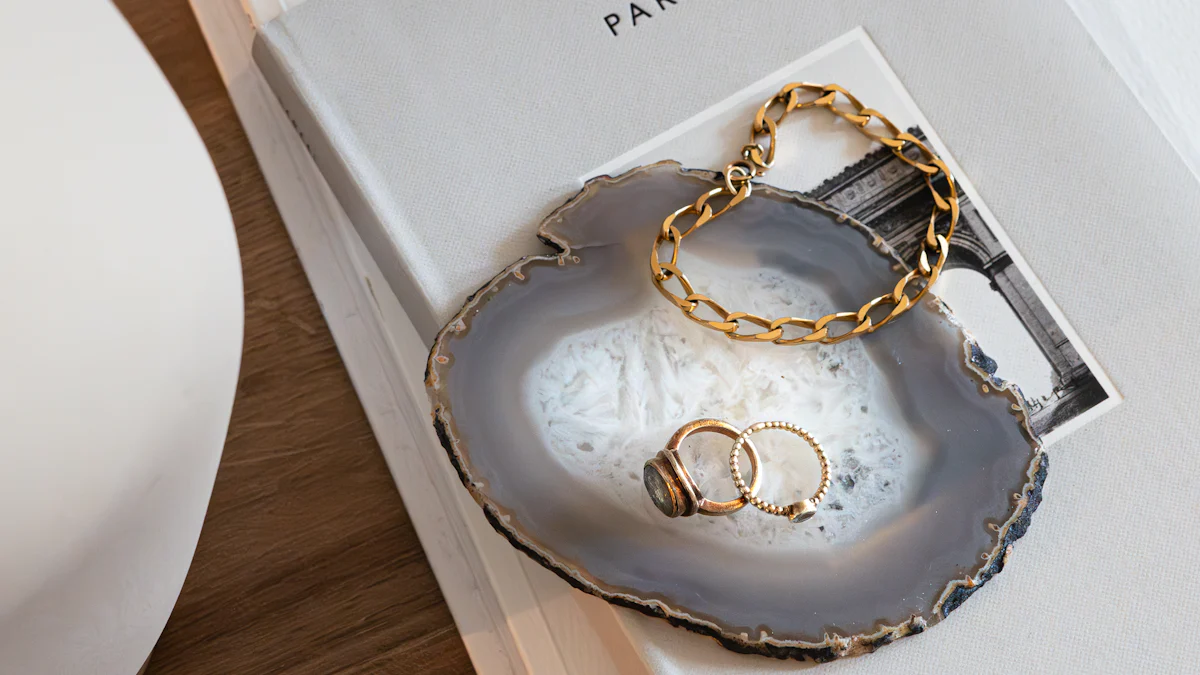What Does CTTW Stand for in Jewelry Explained

When you shop for diamond jewelry, you might notice the term "CTTW" on labels or descriptions. This stands for "carat total weight," which measures the combined weight of all diamonds in a piece. It helps you understand the overall size of the gemstones, whether you're looking at a single-diamond ring or a multi-stone bracelet.
Knowing what does cttw stand for in jewelry is essential for making smart purchases. It directly affects how you evaluate the value of a piece. When you understand CTTW, you can better judge whether the price matches the quality. This knowledge ensures you feel confident and satisfied with your investment.
What Does CTTW Stand for in Jewelry?

Definition of Carat Total Weight
Carat total weight, often abbreviated as CTTW, represents the combined weight of all diamonds or gemstones in a piece of jewelry. This term originates from the historical use of carob seeds as a standard for measuring gemstone weight. Jewelers adopted this method because carob seeds were uniform in size, making them ideal for precise measurements. Today, CTTW provides a clear understanding of the total carat weight in a piece, whether it features a single diamond or multiple stones.
Unlike the term "carat," which refers to the weight of an individual diamond, CTTW encompasses the weight of all stones in a design. For example, a ring with several small diamonds totaling 1.5 carats will have a CTTW of 1.5, even if no single diamond weighs that much. This distinction helps you evaluate the overall size and presence of the gemstones in a piece.
How CTTW Applies to Diamond Jewelry
CTTW plays a crucial role in diamond jewelry, especially in multi-stone designs like engagement rings, tennis bracelets, or cluster earrings. It gives you a comprehensive view of the total carat weight of all diamonds in the piece. For instance, a halo engagement ring might feature a central diamond weighing 1 carat, surrounded by smaller diamonds adding up to 0.5 carats. The total carat weight of this ring would be 1.5 CTTW.
This measurement is particularly helpful when comparing jewelry pieces. Two rings might have the same CTTW, but their designs could differ significantly. One might feature a single large diamond, while the other uses multiple smaller stones. Understanding CTTW allows you to assess which style aligns with your preferences and budget.
Why CTTW Matters for Buyers
Understanding what does CTTW stand for in jewelry helps you make informed decisions. It directly impacts the perceived value of diamond jewelry. A higher total carat weight often suggests a more substantial and luxurious piece. However, CTTW alone doesn’t determine quality. Factors like cut, color, and clarity also play a significant role in the overall value of diamonds.
When shopping for engagement rings or other diamond jewelry, knowing the CTTW ensures you understand what you’re paying for. It prevents confusion between the weight of individual diamonds and the total weight of all stones. This knowledge empowers you to compare pieces effectively and choose one that meets your expectations in terms of size, style, and price.
How Is CTTW Calculated?
The Formula for Calculating CTTW
Calculating cttw is straightforward. You determine it by adding the carat weight of each diamond in the jewelry. This formula applies to all types of diamond jewelry, whether it features a single stone or multiple diamonds. For example, if a ring has three diamonds weighing 0.5, 0.3, and 0.2 carats, the cttw measurement equals 1.0. This total weight of gemstones helps you understand the overall size and presence of the diamonds in the piece.
This calculation is essential for evaluating diamond carat weight accurately. It ensures you know the combined weight of all diamonds, which directly impacts the jewelry's value and appearance.
Examples of CTTW in Jewelry
Single-Diamond Jewelry
In single-diamond jewelry, the cttw measurement equals the carat weight of the single stone. For instance, a 1 carat diamond solitaire ring has a cttw of 1.0. This simplicity makes it easy to compare pieces using a diamond size chart. You can quickly assess how the diamond carat size aligns with your preferences.
Multi-Diamond Jewelry
Multi-diamond jewelry requires summing the carat weight of all stones. A tennis bracelet with 20 diamonds, each weighing 0.1 carats, has a cttw of 2.0. This measurement helps you evaluate the total weight of gemstones in intricate designs. Comparing pieces with similar cttw values but different styles becomes easier when you use a diamond carat size chart.
Factors That Influence CTTW Accuracy
Several factors can affect the accuracy of cttw measurement. Jewelers rely on precise tools to measure diamond carat weight. However, slight variations in cutting or setting can impact the final calculation. Additionally, the inclusion of non-diamond stones in the design may alter the perceived cttw. Always verify the cttw with certification to ensure you receive accurate information about the total weight of gemstones in your jewelry.
The Importance of CTTW in Jewelry Valuation
CTTW and Pricing of Diamond Jewelry
Carat total weight plays a significant role in determining the price of diamond jewelry. It provides an estimate of the combined weight of all diamonds in a piece. A higher CTTW often indicates a more valuable item. For example, a necklace with a CTTW of 3.0 will generally cost more than one with a CTTW of 1.5. This is because larger diamonds are rarer and require more resources to mine and cut, which increases their value.
However, CTTW is not the only factor that influences diamond price. The quality of the diamonds, including their cut, color, and clarity, also plays a critical role. A piece with a higher CTTW but poor diamond clarity may cost less than a smaller piece with exceptional clarity and cut. Understanding how CTTW interacts with these factors helps you evaluate whether a piece is priced fairly.
CTTW and Perceived Value
CTTW significantly impacts how you perceive the value of diamond jewelry. It gives you a clear understanding of the total weight of gemstones in a piece, which can enhance its visual appeal. Larger carat weights often create a sense of luxury and grandeur. For instance, an engagement ring with a CTTW of 2.0 may appear more impressive than one with a CTTW of 1.0.
However, perceived value goes beyond just weight. The quality of the diamonds, including their clarity and cut, also affects how you view a piece. A well-cut diamond with excellent clarity can sparkle more brilliantly, making it appear more valuable even if its CTTW is lower. By considering both CTTW and diamond clarity, you can better assess the overall value of a jewelry piece.
Comparing Jewelry Pieces Using CTTW
CTTW provides a useful way to compare different pieces of jewelry. It gives you a quantitative measure of the total weight of gemstones, helping you gauge their visual impact and value. For example, when choosing between two engagement rings, you can use CTTW to determine which one has more diamonds or larger stones.
However, CTTW alone doesn’t tell the full story. You should also consider the design and quality of the diamonds. A ring with a higher CTTW but poorly cut stones may not look as appealing as one with a lower CTTW but excellent craftsmanship. By combining CTTW with other factors like clarity and cut, you can make a more informed decision that aligns with your preferences and budget.
Common Misconceptions About CTTW
CTTW vs. Individual Diamond Quality
Many buyers mistakenly believe that a higher cttw automatically means better quality. This assumption overlooks the importance of individual diamond characteristics like cut, clarity, and color. While cttw measures the total weight of all diamonds in a piece of jewelry, it does not reflect the quality of each stone. For example, a necklace with a cttw of 2.0 may feature poorly cut diamonds, reducing its brilliance and appeal.
You should also remember that cttw does not account for craftsmanship or design. A piece with a high cttw but poor craftsmanship may lack the elegance of a well-designed item with a lower cttw. Always evaluate the individual quality of diamonds alongside their total weight to make an informed purchase.
Misunderstanding CTTW and Diamond Size
Another common misconception is equating cttw with the size of a single diamond. Cttw represents the combined weight of all diamonds in a piece, not the size of any individual stone. For instance, a ring with ten small diamonds totaling 1.0 cttw will look very different from a ring with a single 1.0-carat diamond.
Smaller diamonds may create a dazzling effect when grouped, but they lack the visual impact of a larger stone. When comparing jewelry, consider how the diamonds are arranged and their individual sizes. This approach helps you understand the piece's overall appearance and ensures it meets your expectations.
Misleading Marketing Practices Around CTTW
Some marketing practices can create confusion about cttw. Jewelers may emphasize a high cttw to make a piece seem more valuable, even if the diamonds are of low quality. For example, a bracelet with a cttw of 3.0 might include stones with poor clarity or color, reducing its overall worth.
You should also watch for pieces that mix diamonds with other gemstones. While these designs can be beautiful, the cttw may include the weight of non-diamond stones, which can mislead buyers. Always ask for certification and documentation to verify the quality and composition of the jewelry. This step ensures you know exactly what you are purchasing.
A Buyer’s Guide to Evaluating CTTW

Considering CTTW Alongside the 4Cs
When evaluating cttw, you should also consider the 4Cs of diamond quality: cut, color, clarity, and carat weight. These factors work together to determine the overall beauty and value of a diamond. While a higher cttw often suggests a more substantial piece of jewelry, it doesn’t guarantee quality.
- Cttw influences the price of diamond jewelry. Pieces with higher cttw typically cost more.
- The cut of a diamond affects its brilliance and sparkle, making it a key factor in your decision.
- Color and clarity impact the visual appeal of diamonds. Poor clarity or noticeable color can reduce the desirability of a piece, even if it has a high cttw.
- Balancing cttw with the quality of the diamonds ensures you get a piece that meets your expectations.
By considering these aspects, you can make a well-rounded decision that aligns with your preferences and budget.
Asking for Certification and Documentation
Always request certification and documentation when purchasing diamond jewelry. These documents verify the authenticity and quality of the diamonds, ensuring you receive accurate information about their cttw, clarity, and other characteristics.
Look for certifications from reputable organizations like the Gemological Institute of America (GIA). These reports provide detailed insights into the diamonds’ cut, color, clarity, and carat weight. They also confirm the accuracy of the cttw measurement.
Without proper documentation, you risk overpaying for a piece that doesn’t meet your expectations. Certification acts as a safeguard, giving you confidence in your purchase.
Comparing CTTW Across Similar Jewelry Pieces
Comparing cttw across similar jewelry pieces helps you evaluate their overall size and value. This approach allows you to assess the visual impact of different designs and make informed decisions.
- Understanding cttw helps you gauge the total weight of diamonds in a piece.
- Comparing pieces with similar cttw values highlights differences in design and craftsmanship.
- You can choose a piece that fits your style and budget while maximizing its visual appeal.
For example, two engagement rings with the same cttw might look entirely different. One may feature a single large diamond, while the other uses multiple smaller stones. By comparing these options, you can select the one that best suits your preferences.
Choosing Reputable Jewelers
Selecting a reputable jeweler is one of the most important steps when purchasing diamond jewelry. A trustworthy jeweler ensures you receive high-quality pieces and accurate information about your purchase. You should take time to research and evaluate jewelers before making a decision.
Start by looking for jewelers with strong reputations in the industry. Read customer reviews and testimonials online. Positive feedback from other buyers often indicates reliable service and quality products. You can also ask friends or family for recommendations if they have purchased jewelry recently.
Check if the jeweler provides certifications for their diamonds. Reputable jewelers offer documentation from trusted organizations like the Gemological Institute of America (GIA). These certifications confirm the authenticity and quality of the diamonds, including their carat weight, cut, color, and clarity. This step is especially important when buying a diamond engagement ring or other high-value items.
Visit the jeweler in person if possible. Observe how they interact with customers. A good jeweler will answer your questions patiently and provide detailed explanations about their products. They should also offer a clear return or exchange policy, giving you peace of mind about your purchase.
Compare prices across multiple jewelers. While lower prices may seem appealing, they can sometimes indicate lower-quality diamonds or misleading practices. Focus on finding a jeweler who balances fair pricing with excellent craftsmanship and service.
By choosing a reputable jeweler, you ensure your engagement ring or other jewelry meets your expectations. This decision protects your investment and guarantees a satisfying shopping experience.
Understanding CTTW is essential when evaluating diamond jewelry. It helps you differentiate between the total weight of all stones and individual weights, ensuring accurate value assessments. This knowledge also impacts pricing, insurance, and resale considerations, making it a critical factor for long-term satisfaction with your jewelry investments.
When purchasing diamond jewelry, consider CTTW alongside the 4Cs—cut, color, clarity, and carat weight. This approach ensures you balance size with quality, leading to a more informed decision. By understanding CTTW, you can confidently choose pieces that align with your style, budget, and future needs.
FAQ
What is the difference between CTTW and carat weight?
CTTW refers to the combined weight of all diamonds in a piece, while carat weight measures a single diamond's weight. For example, a ring with one 1-carat diamond has a carat weight of 1.0, but a ring with multiple diamonds totaling 1 carat has a CTTW of 1.0.
Does a higher CTTW mean better quality?
No, CTTW only measures the total weight of diamonds. It doesn’t reflect their quality. Factors like cut, clarity, and color determine the quality of diamonds. A piece with a lower CTTW but high-quality diamonds can look more appealing than one with a higher CTTW.
Can CTTW include non-diamond stones?
Yes, some jewelers include the weight of non-diamond stones in the CTTW. Always ask for certification to confirm whether the CTTW refers exclusively to diamonds or includes other gemstones. This ensures you know exactly what you’re purchasing.
How does CTTW affect the price of jewelry?
CTTW influences the price by indicating the total weight of diamonds. Larger total weights often cost more. However, diamond quality also plays a significant role. A piece with a lower CTTW but excellent clarity and cut may cost more than one with a higher CTTW.
Why is certification important when evaluating CTTW?
Certification verifies the accuracy of the CTTW and the quality of the diamonds. It ensures you receive authentic information about the jewelry. Without certification, you risk overpaying for a piece that doesn’t meet your expectations.
See Also
Comparing Tungsten Diamond Rings And Traditional Options
Reviewing 10 Carat Lab Grown Tennis Bracelets
Thorough Review Of 5 Carat Lab Grown Tennis Bracelet

